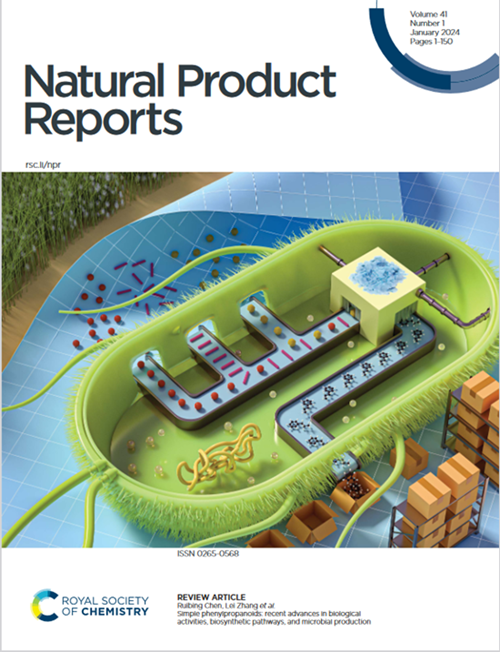玫瑰孢链霉菌中达托霉素生物合成的调控:从基因组分析和合成生物学中获得新见解,加速脂肽的发现和商业化生产
IF 10.6
1区 化学
Q1 BIOCHEMISTRY & MOLECULAR BIOLOGY
引用次数: 0
摘要
覆盖 2005-2024 年本文章由计算机程序翻译,如有差异,请以英文原文为准。


Regulation of daptomycin biosynthesis in Streptomyces roseosporus: new insights from genomic analysis and synthetic biology to accelerate lipopeptide discovery and commercial production
Covering 2005–2024
Daptomycin is a clinically important antibiotic that treats Gram-positive infections of skin and skin structure, bacteremia, and right-sided endocarditis, including those caused by methicillin-resistant Staphylococcus aureus (MRSA). Daptomycin is now generic, and many companies are involved in manufacturing and commercializing this life-saving medicine. There has been much recent interest in improving the daptomycin fermentation of Streptomyces roseosporus by mutagenesis, metabolic engineering, and synthetic biology methods. The genome sequences of two strains discovered and developed at Eli Lilly and Company, a wild-type low-producer and a high-producer induced by N-methyl-N′-nitro-N-nitrosoguanidine (MNNG) mutagenesis, are available for comparitive studies. DNA sequence analysis of the daptomycin biosynthetic gene clusters (BGCs) from these strains indicates that the high producer has two mutations in a large promoter region that drives the transcription of a giant multicistronic mRNA that includes all nine genes involved in daptomycin biosynthesis. The locations of translational start and stop codons strongly suggest that all nine genes are translationally coupled by overlapping stop and start codons or by 70S ribosome scanning. This report also reviews recent studies on this promoter region that have identified at least ten positive or negative regulatory genes suitable to manipulate by metabolic engineering, synthetic biology and focused mutagenesis for strain improvement. Improvements in daptomycin production will also enable high-level production of novel lipopeptide antibiotics identified by genome mining and combinatorial biosynthesis, and accelerate clinical and commercial development of superior lipopeptide antibiotics.
求助全文
通过发布文献求助,成功后即可免费获取论文全文。
去求助
来源期刊

Natural Product Reports
化学-生化与分子生物学
CiteScore
21.20
自引率
3.40%
发文量
127
审稿时长
1.7 months
期刊介绍:
Natural Product Reports (NPR) serves as a pivotal critical review journal propelling advancements in all facets of natural products research, encompassing isolation, structural and stereochemical determination, biosynthesis, biological activity, and synthesis.
With a broad scope, NPR extends its influence into the wider bioinorganic, bioorganic, and chemical biology communities. Covering areas such as enzymology, nucleic acids, genetics, chemical ecology, carbohydrates, primary and secondary metabolism, and analytical techniques, the journal provides insightful articles focusing on key developments shaping the field, rather than offering exhaustive overviews of all results.
NPR encourages authors to infuse their perspectives on developments, trends, and future directions, fostering a dynamic exchange of ideas within the natural products research community.
 求助内容:
求助内容: 应助结果提醒方式:
应助结果提醒方式:


